Japan wants to monitor the elderly with robots, which says a lot about what’s wrong with Abenomics
Months before the concept of Abenomics even existed, Masaaki Shirakawa, the former Bank of Japan governor, made an unusual argument for why it won’t work.
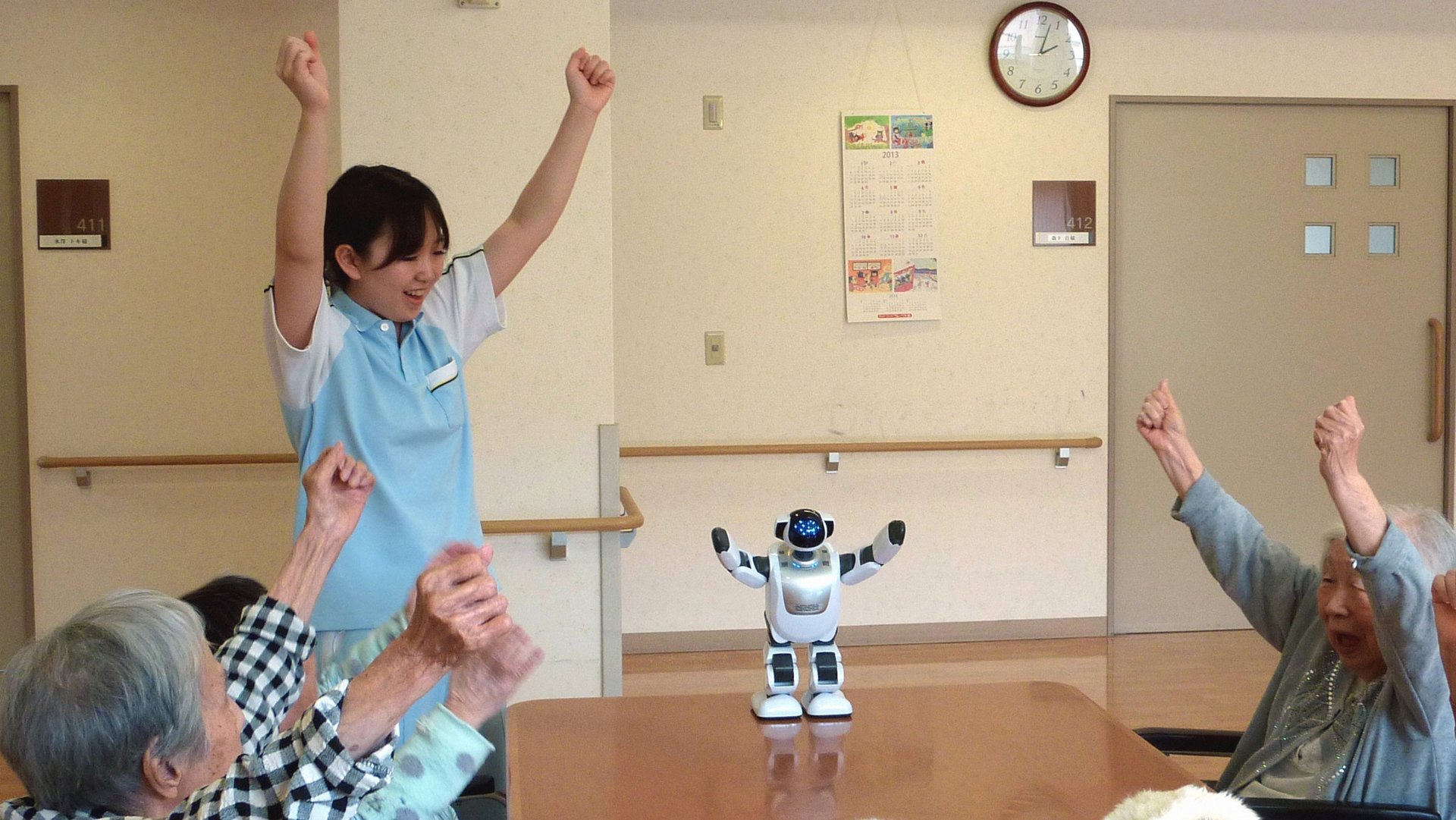

Months before the concept of Abenomics even existed, Masaaki Shirakawa, the former Bank of Japan governor, made an unusual argument for why it won’t work.
“In aging economies…[because] the scarce labor force imposes a natural constraint on labor supply, the marginal product of capital declines accordingly,” Shirakawa said in a speech. ”As a result, macroeconomic growth would be impeded (pdf, p.8).”
And now in plain English: Japan’s aging caused its deflationary spiral. If Shirakawa is right, Abenomics is doomed.
Demographics are the pink elephant of Abenomics
Abe’s recent speech on his structural reform program made no concrete mentions of how he plans to confront Japan’s aging crisis. And use of the word “crisis” isn’t overblown: The Japanese are aging at the fastest rate of any country on the planet. The overall population began shrinking in 2005, while its working population peaked in 1995 (pdf, p.6). No amount of deregulation, which is essentially what Abe is proposing, is going to offset that demographic shift.
The only way to fight demographics is to address them directly, which Abe’s structural reform program doesn’t do. To his credit, his plan includes some efforts to get women into the workforce, which, as we’ve said before, can slow the impact of aging. But those reforms are minor. Here’s a look at the problem:
Japan hosts the world’s heartiest old people, and that’s a problem
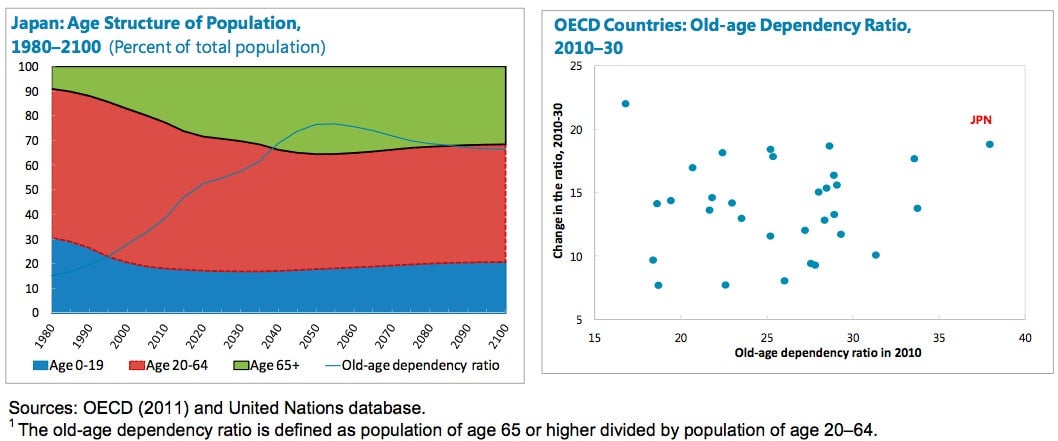
Aging affects many advanced economies, but a few things set Japan apart. Unlike other advanced economies, Japan never experienced a postwar baby boom. The country also hosts some of the planet’s longest living people—the Japanese hang around more than a year longer than the elderly in any Western country. Blame sushi.
An aging population eventually drags on economic growth, as more elderly people exit the workforce and soak up public services. Other advanced economies have combatted this problem by encouraging more women and immigrants to enter the workforce. But that hasn’t panned out in Japan:
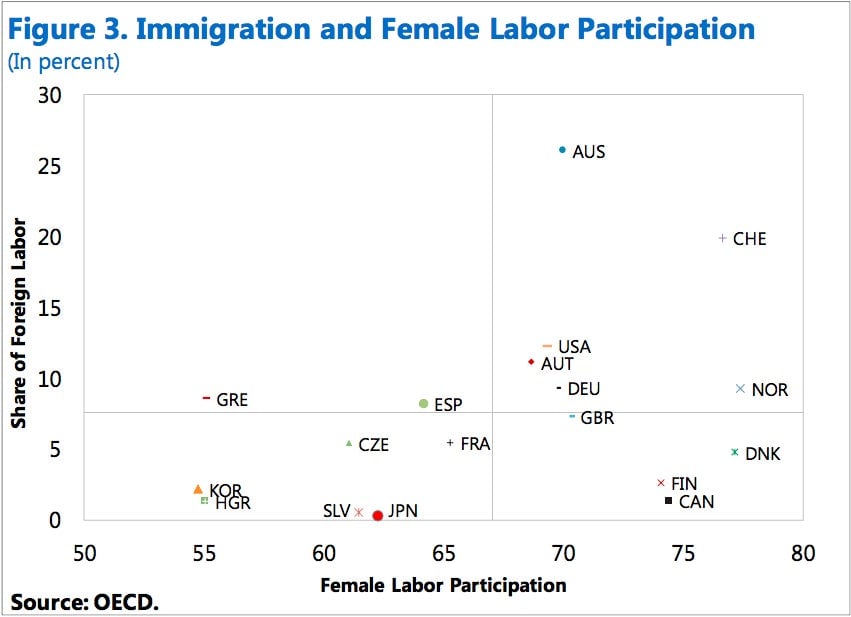
As a result, Japan’s workforce began shrinking earlier than those of other developed countries. By 2025, Japan will have around 14 million fewer workers than it did in 2005, plus an additional 10 million seniors. That means that by 2050, workers will only account for roughly half of Japan’s population. Here’s how Japan compares with other advanced economies on that front:
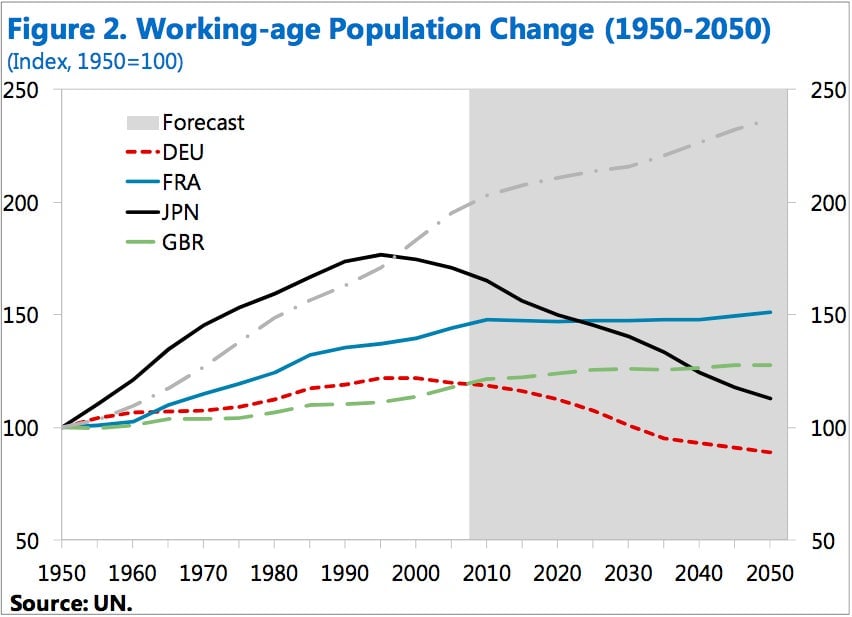
That will leave Japan with fewer workers to support each oldster. Back in 1950, Japan had 10 workers to support each senior. By 2000, that had fallen to 3.6; in 2025, the ratio will be just 1.9.
Japan’s elderly are a budgetary ball and chain
As the burden of retirees multiplies, workers will have to pay higher taxes to fund government programs for the aging. But the government is already overburdened with debt; its debt to GDP ratio is on track to hit 240% next year:
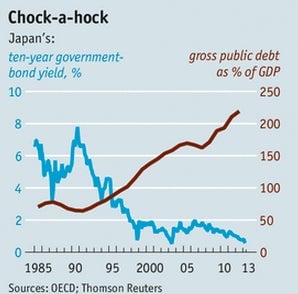
Most of Japan’s government’s debt issues relate to elderly care, which drives up pension payouts and medical care expenditures:
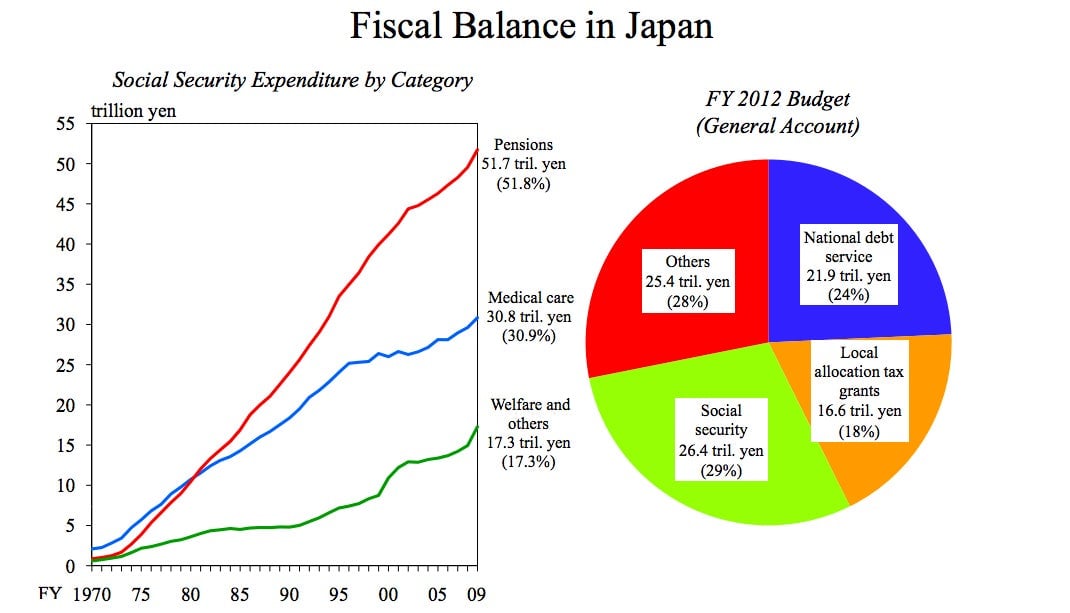
In theory, the government could raise taxes to address growing deficits. But that might lead its citizens to pull back on spending, worsening its deflationary spiral.
That’s why the fiscal stimulus prescribed under Abenomics skirts tax cuts and focuses more on investing in public projects. And yet, public projects aren’t likely to move the needle on consumer spending, which the economy desperately needs to grow.
Short-term solutions won’t fix long-term problems
If Japan’s economic woes stem mostly from its demographic problems, no amount of fiscal or monetary policy will fix the economy long-term. Abe’s proposals are merely a bandaid.
Ultimately, fixing the economy requires more workers. And how do you get more workers? First, Japan can recruit more of its working-age women into the workforce. It also needs to attract more foreign workers. How many?
The UN projects Japan needs 400,000 immigrants a year from 2005 until 2040 just to keep its population from shrinking. To actually increase the labor force by 1% annually, Japan would need to lure roughly 700,000 to 800,000 emigres. Here’s a projection showing how an influx of 400,000 immigrants each year would offset Japanese aging:
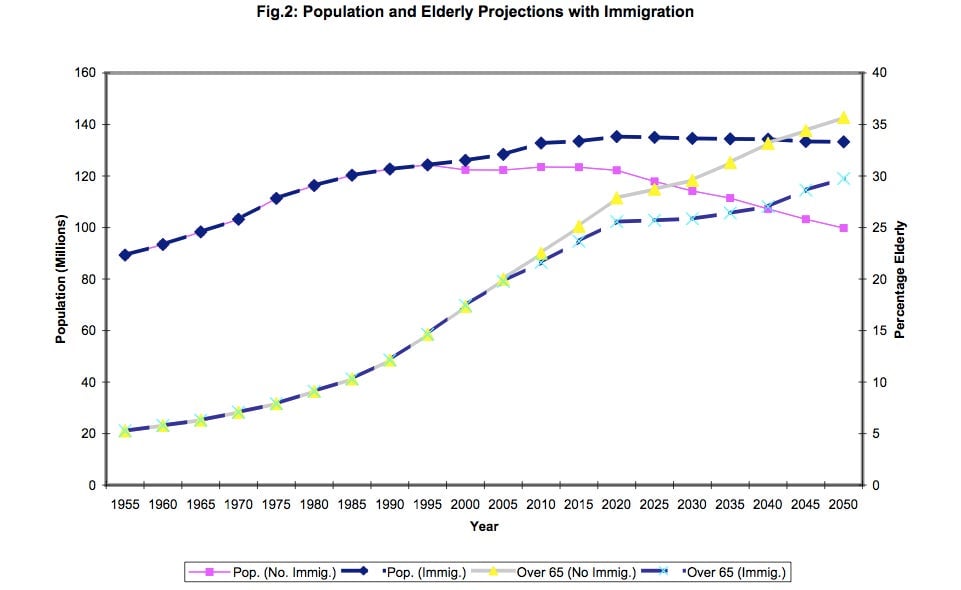
According to Japan-focused economist Robert Dekle, that immigrant bump would reduce government spending as a percentage of GDP from 27% in 2015 to 22% in 2040 (pdf). Based on his calculations, annual GDP growth would gain 1.1 percentage points with those extra 400,000 newcomers. That would make Japan’s GDP 50% higher in 2040 than it would have been otherwise.
Swelling numbers of working immigrants would also help expand Japan’s tax rolls—which the country desperately needs to address its unsustainable debt load. Social security and healthcare spending would fall relative to GDP. And the tax burden would spread out over more workers, boosting consumption.
Japan’s immigration system is terrible
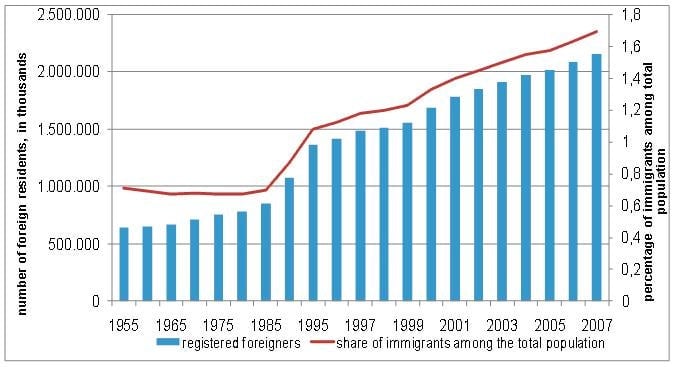
Importing 400,000 foreign workers might seem manageable, given that countries like the US attract around 1 million immigrants every year. But unlike Japan, the US is culturally, institutionally and bureaucratically open to immigration. Japan isn’t. As of 2011, about 2.07 million foreigners lived in Japan, making up nearly 2% of the total population. That percentage has been declining since the 2011 earthquake. As you can see, that means net immigration has slowed since 2007:
Japan’s current immigration policies are geared toward three classes of foreigners. The first is the high-skilled workers (for example, doctors, academics, computer scientists). The second is foreign-born people of Japanese descent, known in Japanese as “Nikkeijin,” who emigrate and find jobs without restrictions. It also invites “trainees,” which is sort of like hiring a ton of interns and having them do your work for free. But these aren’t really immigrants, since they only stay for three years. One in three foreign workers in Japan is an unskilled temporary worker. There are also regional migrants who enter the country informally.
All of these groups have a tough time because the system is notoriously hostile to immigrants. For example, Japan has no anti-discrimination laws, and ranked in last place of 33 developed nations in a study done by the Migration Policy Index. And the road to permanent residency is long and thorny.
Japan is attracting the wrong kind of immigrant
Normally, high-skilled foreign workers are particularly helpful in boosting economic growth. And that’s exactly the kind of immigrant Japan has been targeting. Reforms introduced last year have opened up the system to high-skilled immigrants in academic research, business management and technical work. The country is also recruiting foreign students, most of them from China.
However, at the moment Japan already has a glut of high-skilled workers. “Over time some of the higher order jobs will [need to be filled by] skilled immigrants,” says Bhaskar Chakravorti, executive director for the Institute for Business in the Global Context at Tufts University. ”Certainly, initially you want the low wage jobs because those are the low hanging fruit,” Chakravorti tells Quartz. “To a large extent they’ve automated at lot of their higher end industries so it would be helpful to bring in people at the lower end, to take on service sector jobs.”
The service sector tends to retain more human jobs, which boosts employment. And again, more jobs mean more taxed paid and goods consumed. “It could be self-reinforcing cycle that could turn many of [Japan’s] challenges around,” says Chakravorti.
Healthcare could serve this need. As the FT notes, the sector underproduces relative to the OECD average (paywall). Labor shortages are part of the problem (Japan will need almost 900,000 health-care workers by 2025, according to some estimates), and there’s room for improvement. For example, a government initiative to attract foreign nurses has brought in nearly 600 since 2008, but only 66 have managed to pass the notoriously difficult nursing proficiency test, which requires fluency in written Japanese.
It will take more than eldercare robots to fix the aging crisis
Japan’s biggest growth opportunity, says Tufts’ Chakravorti, is in eldercare and childcare. Eldercare and childcare are extremely labor intensive, since the ratio of workers to customers (the customers being old people or babies) is very high.
Boosting that sector would increase worker productivity, partly because it would allow more highly-skilled mothers to enter the workforce. Such has been the case in the US, as we’ve discussed before. 70% of Japanese women leave the workforce to give birth; fewer than half of them are able to re-start their careers. Good childcare options would also encourage Japanese women to have more children, which would help boost the ratio of old people to young ones.
At the moment, Japanese citizens aren’t legally allowed to hire foreign domestic workers to help out with elderly family members or children. Only foreigners with fancy visas (e.g. “diplomat” or “investor/business manager”) can sponsor domestic helpers from overseas. One government solution has been to pour millions of dollars into engineering robots to monitor old people. Given that Abe made no mention of immigration in his speechifying about Abenomics, he appears satisfied to leave it at that.